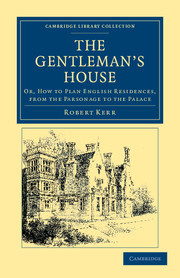The Gentleman's House Or, How to Plan English Residences, from the Parsonage to the Palace Cambridge Library Collection - British and Irish History, 19th Century Series
Langue : Anglais
Auteur : Kerr Robert

This 1864 guide to stately-home building for 'gentlemen', by a leading architect, includes a history of British domestic life.
After Scottish architect Robert Kerr (1823?1904) published this book in 1864, he was given a commission to build what would become his best-known work, Bearwood House, in Berkshire, for the then proprietor of The Times of London, John Walter. Kerr gives a thorough explanation of the elements involved in the planning and building of a 'comfortable English Residence of the better sort' in this book, which is divided into five parts. The first gives a detailed historical account of the 'domestic plan' from the eleventh century to the present day. The subsequent sections leave no corner of a manor house unexamined, as Kerr discusses every room of such houses, their grounds, the possible types of architectural styles, and the matter of cost. There is also an extensive appendix of plates of architectural and garden plans, accompanied by explanations, giving a comprehensive guide to mid-Victorian stately-home building.
Preface; Part I. A Sketch of the History and Development of Domestic Plan in England; 1. Programme of the inquiry; 2. Eleventh century: the Saxon time; 3. Eleventh century: the Norman time; 4. Twelfth century; 5. Thirteenth century; 6. Fourteenth century; 7. Fifteenth century; 8. Sixteenth century; 9. Seventeenth century; 10. Eighteenth century; 11. Nineteenth century; Part II. Exposition of Plan as Now Practised: Introductory Chapter: Classification of apartments; First Division. The Family Apartments: 1. General considerations; 2. The day rooms; 3. The sleeping rooms; 4. The children's rooms; 5. The supplementaries; 6. The thoroughfares; Second Division. State Rooms, etc.; Third Division. The Domestic Offices: 1. General considerations; 2. The kitchen offices; 3. The upper servants' offices; 4. The lower servants' offices; 5. The laundry offices; 6. The bakery and brewing offices; 7. Cellars, storage, and outhouses; 8. The servants' private rooms; Fourth Division. The Stabling and Farm Offices, etc.; Part III. Notes on Site and the Grounds: Introduction; 1. The choice of locality; 2. The choice of site; 3. The arrangement of the grounds and adjuncts; Part IV. Notes on Architectural Style: 1. Introduction; 2. Elizabethan style; 3. Palladian style; 4. Elizabethan style revived; 5. Rural Italian style; 6. Palatial Italian style; 7. French-Italian style; 8. English Renaissance style; 9. Medieval or Gothic style; 10. Cottage style; 11. Scotch Baronial style; 12. Concluding remarks; Part V. Notes on Accommodation and Cost: 1. Preliminary data; 2. Modes of estimating; 3. Supplementary expenses; 4. Calculation of prices, cubical and superficial; 5. Example of a house of the value of 1250L; 6. Example of a house of the value of 2500L; 7. Example of a house of the value of 5000L; 8. Example of a house of the value of 10,000L; 9. Example of a house of the value of 20,000L; 10. Example of a house of the value of 40,000L or upwards; 11. Estimate of stabling and farm offices; Part VI. Appendix: critical notes on the plates.
Date de parution : 03-2012
Ouvrage de 600 p.
14x21.6 cm
Thème de The Gentleman's House :
© 2024 LAVOISIER S.A.S.



